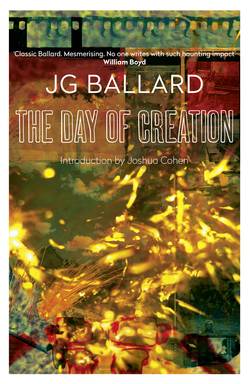Читать книгу The Day of Creation - J. G. Ballard, John Lanchester, Robert MacFarlane - Страница 8
2
ОглавлениеIn 1984 Ballard published his first and only overtly autobiographical novel, which was also his first and only mainstream success, Empire of the Sun. In 1987, the film version appeared, and Ballard’s next novel was published – The Day of Creation, whose somniloquent symbolism alienated whatever new audience Empire had earned, and failed to interest the old audience already alienated by the Hollywoodization – the Spielberging – of a cult author and genre-totem (who was also a 57-year-old single father of three). The Day of Creation has never been filmed, though it’s already a series of action scenes strewn with dialogue sparse enough for the markets abroad. What augurs against adaptation, however, is that it has no elevator-pitch – no plot.
The hero of The Day of Creation is Dr Mallory, a Brit born in Kowloon, Hong Kong (Ballard was born in Shanghai), trained in Ireland as a physician (Ballard trained at Cambridge to be a physician), who now administers a clinic for the World Health Organization in Port-la-Nouvelle, the second city/shantytown of an unnamed, formerly French colonial ‘war-locked nation, that lay between the borders of Chad, the Sudan, and the Central African Republic in the dead heart of the African continent’. That war pits General Harare’s guerilla units against a paramilitary police force commanded by Captain Kagwa. Repeated clashes have wrecked Port-la-Nouvelle’s viaducts and reservoir, left the local Lake Kotto dry, and sent the engineers involved with irrigation drilling fleeing back to Belgium. Mallory is captured and about to be executed by Noon, a prepubescent girl and Harare rebel, but her rifle jams, and her co-revolutionaries scatter to the forest with the arrival of Kagwa’s squadrons and the landing of a twin-engine Dakota chartered to Air Centrafrique. Mallory’s life is saved, or his death is, with a popcorny fortuity. If the rifle had functioned properly the rest of the novel would’ve been the soul’s passage through delirium, and all its waterways would be the Styx.
The Dakota’s passengers are Professor Sanger, an Australian-German ‘sometime biologist turned television popularizer’, and his Indian protégé Mr Pal, who’ve come to deliver five tons of rice donated by West Germany – to a populace that has never eaten rice, to an uninhabited town – and to make a self-financed documentary – about the war, about Kagwa, about anything – for Africa Green, a ‘television charity’, which maintains ‘satellite links with the major Japanese networks’.
Sanger settles for producing agitprop by and about and even for Kagwa – a viewership of one. Mallory, meanwhile, maniacally schemes to reverse the drought. Literature teems with mad mariners – Mallory is its foremost mad hydrologist. He suspects, or prophesies, an underground limestone aquifer, and in the course of his divination campaign orders one of Kagwa’s sergeants to remove the stump of an ancient fallen oak. The tractor extracts the gnarled root-bole – ‘like the petrified heart of an extinct bull, or the crown of an underworld deity ripped from the ceiling of a subterranean palace’ – and exposes ‘an open mouth wide enough to swallow a small car’. But then water fills the cavity, black water, which gradually overflows it, and floods Lake Kotto, and washes the earth blank of its town: boats become the only tenable dwellings, as the Sahara engreens into ‘an Eden’.
Mallory purchases the river from Kagwa for $1000 US. Sanger senses an opportune subject for his documentary, and shoves his camera and mic in the doctor’s face, but only after he registers the river with the National Geographic Society in Washington, DC, naming it the Mallory. Noon, whether out of penance for her execution attempt, or in gratitude for the H20, assists Mallory in commandeering a car-ferry, the Salammbo, and the two depart toward the river’s source, their objective changing like a stream of consciousness, or becoming a stream of consciousness: One moment Mallory wants to dam the Mallory, the next he wants to destroy it.
All of the above happens in a hundred or so pages. The nearly two hundred pages remaining are pure journey: Kagwa’s pursuit (to reclaim the car-ferry, which contains the Mercedes he bought with the river funds); Harare’s skirmishing; Sanger and Pal coming aboard to collect their leagues of unscripted footage, and the overtaking of the Diana: a ‘brothel-ship’, formerly patronized by oil-riggers, and now under the commission of Mrs Warrender, another Brit, another white, who’d superintended the animal breeding station with her Rhodesian husband, until he was slaughtered …
